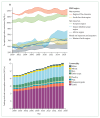The 2020 report of The Lancet Countdown on health and climate change: responding to converging crises
- PMID: 33278353
- PMCID: PMC7616803
- DOI: 10.1016/S0140-6736(20)32290-X
The 2020 report of The Lancet Countdown on health and climate change: responding to converging crises
Erratum in
-
Department of Error.Lancet. 2021 Jan 9;397(10269):98. doi: 10.1016/S0140-6736(20)32681-7. Epub 2020 Dec 14. Lancet. 2021. PMID: 33333003 No abstract available.
Abstract
For the Chinese, French, German, and Spanish translations of the abstract see Supplementary Materials section.
Copyright © 2021 Elsevier Ltd. All rights reserved.
Conflict of interest statement
We declare no competing interests.
Figures





























Comment in
-
Health and climate change MJA-Lancet Countdown report: Australia gets another failing grade in 2020 but shows signs of progress.Lancet. 2021 May 15;397(10287):e12-e14. doi: 10.1016/S0140-6736(20)32632-5. Epub 2020 Dec 23. Lancet. 2021. PMID: 33357509 No abstract available.
-
Countdown on health and climate change: too important for methodological errors.Lancet. 2021 Jul 3;398(10294):26. doi: 10.1016/S0140-6736(21)00884-9. Lancet. 2021. PMID: 34217397 No abstract available.
References
-
- McMichael AJ, Haines JA, Slooff R, et al. Climate change and human health: an assessment /prepared by a Task Group on behalf of the World Health Organization, the World Meteorological Association and the United Nations Environment Programme. Geneva, Switzerland: World Health Organization; 1996.
-
- National Aeronautics and Space Administration. GISS surface temperature analysis (GISTEMP v4) 2020. [accessed April 28, 2020]. https://data.giss.nasa.gov/gistemp/
-
- Field CB, Barros VR, Dokken DJ, et al., editors. Intergovernmental Panel on Climate Change. IPCC 2014: climate change 2014: impacts, adaptation, and vulnerability. Part A: global and sectorial aspects. Contribution of working group II to the fifth assessment report of the Intergovernmental Panel on Climate Change. Cambridge, UK and New York, NY: Cambridge University Press; 2014.
-
- UN. United Nations Framework Convention on Climate Change; Report of the Conference of the Parties on its twenty-first session, held in Paris from 30 November to 13 December 2015; 2016. Jan 29, [accessed April 6, 2020]. http://unfccc.int/resource/docs/2015/cop21/eng/10a01.pdf .
-
- Herring SC, Christidis N, Hoell A, Hoerling MP, Stott PA. Explaining extreme events of 2017 from a climate perspective. Bull Am Meteorol Soc. 2019;100:S1–117.
Publication types
MeSH terms
Grants and funding
LinkOut - more resources
Full Text Sources
Other Literature Sources
Medical

